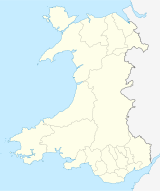The site ofCastell Arnallt,sometimes known asCastle Arnold,is located near the village ofLlanoverin theUsk valleyofMonmouthshire,Wales,some 4 miles (6.4 km) south east ofAbergavenny.It was the fortified court house, orllys,ofSeisyll ap Dyfnwal,lord ofOver GwentorGwent Uwchcoed,before it was destroyed after Seisyll and some of his household were killed atAbergavenny CastlebyWilliam de Braosein 1175. The land is now in agricultural use, with no remains visible.
| Castell Arnallt | |
|---|---|
| Monmouthshire,Wales | |
 Site of Castell Arnallt | |
| Coordinates | 51°47′06″N2°59′13″W/ 51.785°N 2.987°W |
| Type | Castle |
| Site information | |
| Condition | Earthworks - no other visible remains |
History
editOrigin
editCastell Arnallt was a medieval fortification, believed to have been the fortified residence of the Welsh rulers ofOver GwentorGwent Uwch Coed.[1]Together with other manors in the area, it formed part of the estates of Dyfnwal ap Caradog, who may have been based atPenpergwmnear Abergavenny.[2]
Use and destruction in the 12th century
editKingHenry II of Englandrecognised Dyfnwal's son, Seisyll ap Dyfnwal, as lord of Over Gwent orGwent Uwchcoed,with the honour of Abergavenny castle, in return for releasing a hostage, Hugh de Beauchamp. As part of the peace proceedings between The Lord Rhys and Henry II, Seisyll, the Lord Rhys’s brother in law, was persuaded to give the Honour ofAbergavenny Castleto William de Braose.[3]Abergavenny Castle was attacked in 1175 andHenry Fitzmileswas killed, reputedly by Seisyll. The Fitzmiles estate, including Abergavenny Castle, passed toWilliam de Braose,the husband of Henry's sister Bertha.
De Braose called Seisyll to his castle for Christmas in 1175, telling him that his intention was reconciliation. Also invited were other leaders fromGwentand Seisyll's son Geoffrey. In retribution for FitzMiles' death, De Braose had the men killed in the castle's great hall during a feast, an episode known as the Massacre of Abergavenny. His actions included seizing Seisyll's land.[4][5]While Seisyll was at Abergavenny Castle, Castell Arnallt was attacked by retainers of William de Braose, who razed it in a surprise attack[5][6]and killed Seisyll's other son Cadwaladr. Seisyll's wife was either kidnapped or killed during the raid. The final destruction of the castle is dated to 1177.[1]
Subsequent use
editIn 1325 Castell Arnallt was part of the estates gifted to Sir William de Hastings, a relative of the lord of Abergavenny.[2]The only known use of the site after the castle was destroyed is agriculture. The site has been surveyed, but has not been excavated. It has been scheduled as anAncient Monumentsince 1947.[3][7]
The current site
editAll that remains of the castle is a large, oblong mound. It sits in pasture land used for grazing, on the edge of theflood plainof theRiver Usk.There are two enclosures, one on top of the mound and one its western side.[8][9]It appears, from examination of the mound, that there may be structures, a gate, and masonry walls below the surface, built over a period of time. It is believed to have been allys,orroyal court,used for administrative purposes and built prior to 1175. It was considered likely to have been built without a motte, relying on natural formations.[9][10][11]
References
edit- ^ab"Castle Arnold - Castell-Arnallt".Royal Commission on the Ancient and Historical Monuments of Wales.Retrieved18 July2013.
- ^abTrostrey Excavation Group,Penpergwm: medieval manor house and chapel.Retrieved 19 July 2013ArchivedJuly 26, 2013, at theWayback Machine
- ^abPhillips, Neil (Spring 2000)."Abergavenny Castle 1087-1535".Gwent Local History.88:17–31.ISSN0308-0374.Retrieved26 March2018.
- ^"Abergavenny Castle".Brecon Beacons National Park. Archived fromthe originalon 18 July 2013.Retrieved17 July2013.
- ^abRoberts, Geraint (2001).Welsh Castles.Y Lolfa. p. 23.ISBN978-0-86243-550-9.
- ^A Research Framework for the Archaeology of Wales, Southeast Wales – Early MedievalArchived2011-05-17 at theWayback MachineThe Clwyd-Powys Archaeological Trust.
- ^Jones, T. (trans) (1971).Brenhinedd Y Saesson or the Kings of the Saxons, BM.Cotton MS. Cleopatra Bv and The Black Book of Basingwerk NLW MS. 7006. Board of Celtic Studies History and Law Series. Cardiff: University of Wales.
- ^"Castle Arnold - Castell-Arnallt image".Royal Commission on the Ancient and Historical Monuments of Wales.Retrieved18 July2013.
- ^ab"Castle Arnold (Castell Arnalt), Llanover".The Glamorgan-Gwent Archaeological Trust Historic Environment Record.Retrieved18 July2013.
- ^Phillips, Neil (2005).Earthwork Castles of Gwent and Ergyng AD 1050-1250(PhD). University of Sheffield.
- ^Hogg, A.H.A.;King, D.J.C. (1963). "Early Castles in Wales and the Marches".Archaeologia Cambrensis.112:77–124.
External links
edit- Phillips, Neil (Spring 2001)."Castell Arnallt - A Topographical Survey".Gwent Local History.90:8–11.
